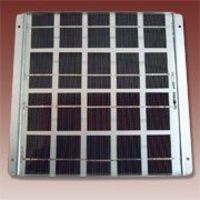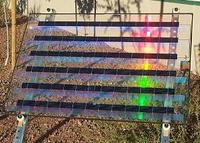This is a great time to be in the solar panel market.
You can sell as much as you make, no matter its efficiency, no matter its size, no matter how it plugs into whatever.
Over the long run that is a huge problem. It’s a big problem for the industry, and a bigger problem for its customers.
With smaller panels, which may have a specific purpose (like running a light on your lawn, or a watch battery) this is no big deal. So long as the panel creates enough power to run the device in question you’re golden. It’s a closed loop.
The trouble comes in when you’re talking about connecting panels to the grid, or trying to choose which panel to buy.
There the lack of standards is bound to be maddening.
So far few people seem to have even thought about this. They’re too busy looking at what to put in a solar panel, or what shapes might yield to the most efficiency. When they talk about "setting new standards," they’re talking about a maximum power output, not about standards in the way the PC industry talks about them. In the last story linked-to above, no one is thinking about how the panels might be replaced when they wear out, and with what.
These are, in many ways, Heathkit days for the industry. We’re uncertain how important concentrating solar power onto panels with mirrors might be, as opposed to adding more panels. The result is that press releases about new panels sound as jargon-filled and unintelligible as a 1974 parts ad in Popular Mechanics:
A product of Evergreen’s
cutting-edge String Ribbon™ manufacturing technology, the 195W panel
has the best available power tolerance (-0 / +2.5%), guaranteeing 100%
of rated power.
Huh? And that’s from a company which considers itself to be on top of what state and federal regulators are thinking.
Consider this story about a new line of panels from China.
It is said to have a 16% efficiency rating and a 20 year life. But how
big is it? How do you replace it? How do you connect it? Are those
connections standard, or must they be replaced?
We need someone to create a set of standard panel sizes, a uniform
efficiency rating, standard connectors for linking panels to a roof and
to the electrical network, and a whole lot of public education on what
to look for.
I know we’re going to see a lot of experimenting, still —
holograms, concentrators, new materials, new pigments, new
manufacturing techniques — but standards can eliminate objections
later, and make certain today’s buyers aren’t throwing money down a
rathole now.













China’s Growing Solar Energy Sector
The world is hungry from solar energy technology and China is quickly developing the worlds leading (or at least fastest growing) solar energy corporate scene. Chinalysts Chinese Solar Stocks Comparison Table that gives a good overview of the diff…
China’s Growing Solar Energy Sector
The world is hungry from solar energy technology and China is quickly developing the worlds leading (or at least fastest growing) solar energy corporate scene. Chinalysts just published a Chinese Solar Stocks Comparison Table that gives a good ove…
Governmnet is doing late to bring in standards of solar energy. It will soon become in mainstream and i guess there should be some policy regarding it
Governmnet is doing late to bring in standards of solar energy. It will soon become in mainstream and i guess there should be some policy regarding it
Let’s start using this alternative power and save energy..
https://www.yousendit.com/transfer.php?action=batch_download&send_id=817789614&email=7cff47bb7cdcb76fbfa15e66c81a1961
Let’s start using this alternative power and save energy..
https://www.yousendit.com/transfer.php?action=batch_download&send_id=817789614&email=7cff47bb7cdcb76fbfa15e66c81a1961